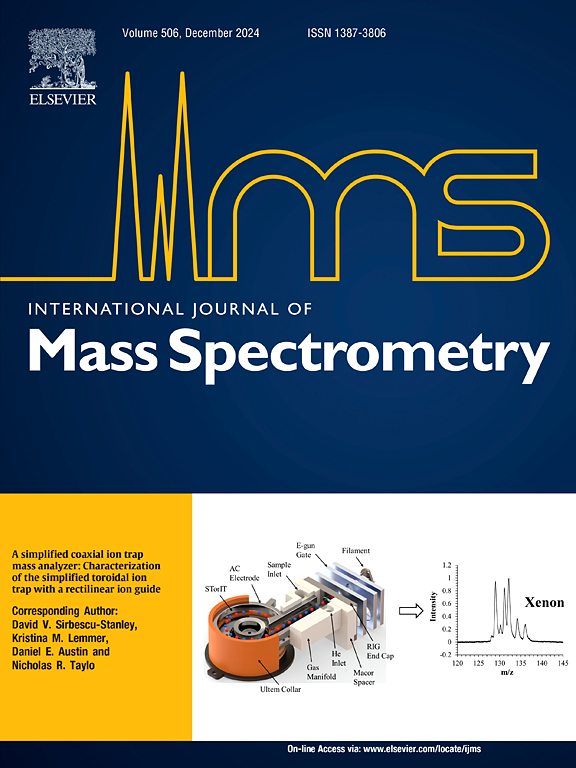Effect of the Tyr5 and His6 substituent groups on the zinc affinities and conformational structures of the acetyl-His1-Cys2-Gly3-Pro4-X5-X6-Cys7 heptapeptides
IF 1.7
3区 化学
Q3 PHYSICS, ATOMIC, MOLECULAR & CHEMICAL
引用次数: 0
Abstract
In this study, we investigate the influence of the Tyr5 and His6 substituent groups on the zinc-binding affinities and conformational properties of a series of acetylated heptapeptides, acetyl-His1-Cys2-Gly3-Pro4-X5-X6-Cys7 focusing on the impacts where X5-X6 are either Tyr5-Gly6, Tyr5-His6, Gly5-Gly6, or Gly5-His6. Utilizing traveling-wave ion mobility-mass spectrometry and molecular modeling techniques we analyze the zinc binding interactions and peptide coordination behavior. The zinc binding peptides (ZBPs) relative zinc affinities were measured across pH 5 to pH 10 by monitoring the solution-phase formation of the [ZBP+Zn(II)]− complex by utilizing native MS in negative ion mode to preserve the solution-phase binding of Zn(II) to the peptides. Furthermore, their relative gas-phase Zn(II) affinities were measured using competitive threshold collision-induced dissociation (TCID) of the [ZBP+Zn(II)+NTA]− complex, by modeling the two competing dissociation channels: [ZBP+Zn(II)]− + NTA or [Zn(II)+NTA]− + ZBP, where NTA is nitrilotriacetic acid. Our examinations also tested whether there was an effect of the formation of the [ZBP+Zn(II)+NTA]− complexes from solutions at different pHs, before they are electrosprayed into the gas-phase for the TCID analyses. Both solution- and gas-phase measurements predicted the heptapeptide with the Gly5-His6 residues had the greatest zinc affinity and that the presence of Tyr5 and His6 altered the zinc affinity and induced distinct conformational changes due to changes in the coordination of the zinc. This research enhances our understanding of zinc-peptide interactions, with implications for the design of peptide-based metalloproteins, which may guide the design of novel ZBPs for therapeutic, biotechnological or environmental remediation applications.

Tyr5和His6取代基对乙酰- his1 - cys2 - gly3 - pro4 - x5 - x6 - cys7七肽的锌亲和力和构象结构的影响
在本研究中,我们研究了Tyr5和His6取代基对一系列乙酰化七肽乙酰基- his1 - cys2 - gly3 - pro4 -X5-X6- cys7的锌结合亲和性和构象性质的影响,重点研究了X5-X6为Tyr5- gly6、Tyr5-His6、Gly5-Gly6或Gly5-His6时的影响。利用行波离子迁移质谱和分子模型技术,我们分析了锌的结合相互作用和肽的配位行为。通过使用天然质谱在负离子模式下监测[ZBP+Zn(II)] -络合物的液相形成,以保持Zn(II)与肽的液相结合,测量了锌结合肽(ZBP)在pH 5至pH 10之间的相对锌亲和力。此外,通过模拟[ZBP+Zn(II)+NTA] -络合物的两个竞争解离通道:[ZBP+Zn(II)]−+NTA或[Zn(II)+NTA]−+ ZBP,其中NTA是硝化三乙酸,利用竞争阈值碰撞诱导解离(TCID)测量了它们的相对气相Zn(II)亲和度。我们的研究还测试了不同ph值溶液中[ZBP+Zn(II)+NTA]−络合物的形成是否有影响,然后将它们电喷涂到气相进行TCID分析。溶液和气相测量均预测Gly5-His6残基的七肽具有最大的锌亲和力,并且Tyr5和His6的存在改变了锌的亲和力,并由于锌的配位改变而引起明显的构象变化。这项研究增强了我们对锌-肽相互作用的理解,对设计基于肽的金属蛋白具有重要意义,这可能指导设计用于治疗、生物技术或环境修复的新型zbp。
本文章由计算机程序翻译,如有差异,请以英文原文为准。
求助全文
约1分钟内获得全文
求助全文
来源期刊
CiteScore
3.60
自引率
5.60%
发文量
145
审稿时长
71 days
期刊介绍:
The journal invites papers that advance the field of mass spectrometry by exploring fundamental aspects of ion processes using both the experimental and theoretical approaches, developing new instrumentation and experimental strategies for chemical analysis using mass spectrometry, developing new computational strategies for data interpretation and integration, reporting new applications of mass spectrometry and hyphenated techniques in biology, chemistry, geology, and physics.
Papers, in which standard mass spectrometry techniques are used for analysis will not be considered.
IJMS publishes full-length articles, short communications, reviews, and feature articles including young scientist features.

 求助内容:
求助内容: 应助结果提醒方式:
应助结果提醒方式:


